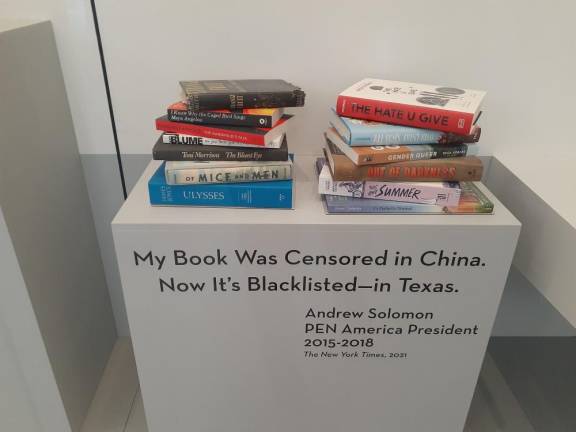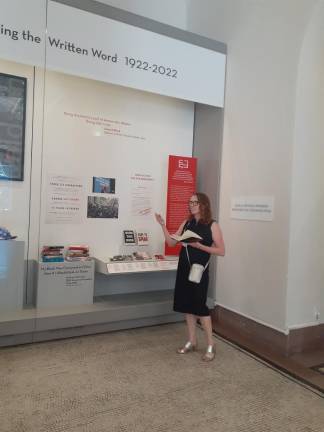The allure of books. And words and writing. The need to connect. These may have been the things that led PEN’s founder, Catharine Amy Dawson Scott to declare “I’ve got an idea – a dining club,” where fellow poets, essayists and novelists could meet, exchange ideas and mingle after suspected long hours of isolation creating their respective masterpieces.
This was in London in 1921, where the first PEN Club of both men and women – unheard of for the time – took shape. A year later, PEN America was formed in New York City, part of the newly expanding PEN International association of writers. It’s been quite a century.
“This is the culmination of a longstanding dream for us at PEN America,” CEO Suzanne Nossel said at the opening of their centenary exhibition “PEN America at 100: A Century of Defending the Written Word” now on view at the New-York Historical Society through October 9. “Wanting to share the history of our organization with the city that has played such a prominent part in building PEN America up and making the organization what it is today.”
Nossel said that what’s striking to her about the organization on its 100th birthday is how it has endured and thrived, without an endowment, without a building or celebrity pitchman, but mainly on the strength of the ideas and the individuals, and the community that has been its anchor.
“It’s fundamentally grounded in the powerful idea that the founders of PEN came up with over a hundred years ago, the notion of writer-to-writer solidarity – that writers have an obligation one to another,” something PEN America has cultivated over the many years, she said. And as an extension, “it has activated the sense for writers that they are custodians of the public interest, that they have a stake in the values and principles that undergird society.”
Writing Freely
This is the PEN America that most New Yorkers know. An organization at the forefront of activism around literature and human rights nationwide, and in solidarity with international partners, PEN fights to preserve the right for writers to keep writing freely and for an audience to have ongoing access to those published works or readings.
“PEN America at 100,” curated by PEN America trustee Bridget Colman with Lisa Kolosek, is a fascinating walk through from the early dining club-meeting, only-published authors era, to the current more than 7,500-member nationwide organization of writing professionals, readers and supporters that make up the PEN literary community.
Names we recognize – Eleanor Roosevelt, Langston Hughes, Arthur Miller, Susan Sontag, Toni Morrison and James Baldwin – among many others, were longtime members at PEN America over the years. The organization’s history is documented through prized archives of letters, photographs, posters, quotes and invitations (there were a lot of cocktail parties in the 50s and 60s!), all prominently displayed on the first floor at the Historical Society.
Nossel said the curators’ contribution to the exhibition have now become a part of PEN’s history.
“Bridget Colman became inspired by the idea of PEN’s history when we first began to talk about what we were going to do for the centenary,” Nossel said. “She took it on herself to bring this to life and add vision and passion and determination and spent weeks in archives across the country, working with Lisa Kolosek, our co-curator and also with our COO, Dru Menaker.”
Nossel added how momentous it was for PEN America to have the exhibition “for all New York to walk through the minute they enter the Historical Society.”
Scanning Barcodes
Colman’s passion and dedication to PEN America’s history and mission shone through as she spoke in depth about the exhibition, the history of the organization, pointing out pivotal moments and documents over the last century to the present. And in an special invitation to young scholars, she says, there are barcodes embedded at the base of the exhibition next to a series of quotes, where she hopes they can read the snapshots, scan the barcodes, and then later expand on information of interest.
On display is also text that acknowledges the current tide of book bannings and rapidly escalating restrictions on free expression and speech worldwide.
“PEN has always reflected on and taken strength from its past,” Colman said. Just as international discourse continued in the past regardless of what was happening across borders “for fun and frolic but also for things that were more intense,” so will discourse and solidarity continue as the literary and human rights landscape continues to change today, she believes.
“The work that PEN is doing now is so vitally important, in my mind – especially in light of conversations about banning books – [and is] vitally important for organizations like PEN to be able to be in the position to fight for freedom of speech, for freedom of expression,” Colman said.
Nossel is looking ahead to the next generation as the fight continues. She says they have established the Free Speech Advocacy Institute to engage young people and help them better understand the fundamentals of free expression worldwide.
“The future is crucial,” she said, regarding their concern that “the mooring of free expression in our own society were under threat if the rising generation didn’t feel a connection to these ideals.”
“PEN America at 100: A Century of Defending the Written Word” is on view at the New-York Historical Society, 170 Central Park West (at 77th Street), through October 9. For museum hours and tickets, visit nyhistory.org.



